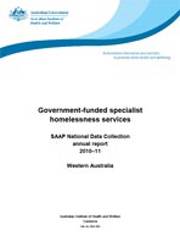Summary
This publication is one of eight state and territory supplements that accompany the 2010–11 annual report on the use of government-funded specialist homelessness services in Australia (AIHW 2011a). Information to aid readers in interpreting the data is presented in the national report and appendixes (AIHW 2011i).
In line with the national picture, service users in Western Australia:
- were mostly female
- were often relatively young
- were mostly non-Indigenous, however, Aboriginal and Torres Strait Islander people were over-represented relative to their population size
- commonly sought support because of interpersonal relationships, such as for domestic or family violence
- immediately on exit from support, were most often living in a house or flat; were not employed; and had a government pension or benefit as their main source of income.
Some other points of interest in Western Australia were:
- the rate of use of specialist homelessness services was lower than the national average
- seeking support primarily because of domestic violence was relatively high
- there has been an increase in seeking assistance because of financial reasons in recent years
- Aboriginal and Torres Strait Islander people used services at levels higher than the national average
- the proportion of Aboriginal and Torres Strait Islander service users has decreased in recent years
- the proportion of Australian-born service users was the lowest of all the states and territories
- the proportion of overseas-born service users has increased in recent years
- clients were supported for relatively short periods, with the lengths of support and accommodation being shorter than the national averages.



